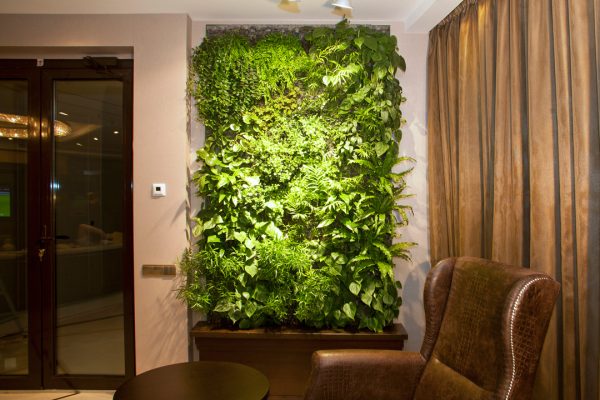Adding various plant elements to housing design has been practiced for a long time, but the phytowall in the apartment is a novelty in the world of interior fashion, which was invented in France only 10 years ago. The phytowall is used for vertical landscaping of the space and acts as an original method of decoration, and also performs a number of practical functions. This design technique is used in homes, apartments and offices. Despite the difficulties, you can do all the work without the help of professionals.
- What is a phytowall
- Phytowall Designs
- The use of phytowalls in apartments and offices
- Plants for phytowalls
- Moss for phytowalls
- Flowers on a phytowall
- Artificial plants
- Grass
- Best plants for phytostalls
- DIY phytowall and phytomodule
- Beginning of work
- Eco module collection rules
- Ideas for additional decor
- Tools and materials for manufacturing
- Assembly and installation of an eco-wall
- Care of a phytowall
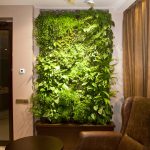
What is a phytowall
Under the phytowall (ecowall) understand a special panel with pockets in which plants are planted, mounted on a vertical plane. Simply put, this is a vertical structure designed for landscaping the interior. Sizes can be very different - from 50-60 cm to several tens of meters. You can use phytowalls indoors and outdoors, but most often they are located in the living room, bathroom or office.
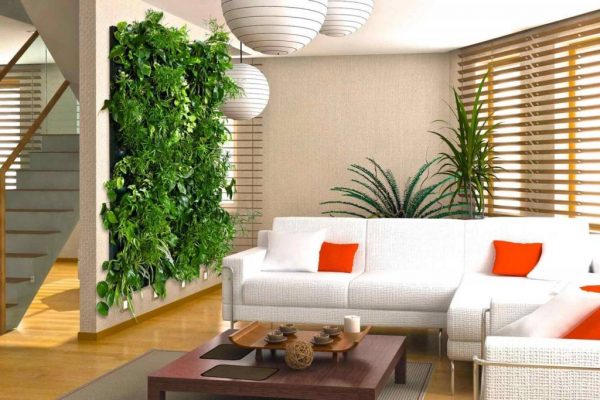
Ecostena looks simply incredible, magnificent, immediately attracting attention. It fills the space with saturated color, brightness and a pleasant smell of greenery. In addition, the use of phytowalls solves a number of other problems and has many advantages:
- elimination of dirt, dust - plants literally attract flying pollution, and the air becomes cleaner;
- health benefits - humidity, oxygen saturation are optimized, the microclimate in the house improves;
- comfort in a dream - in oxygen-rich air a person has a better rest, sleeps better;
- safety - this type of decoration is environmentally friendly, 100% suitable for children's rooms, perfectly replaces other types of materials;
- zoning of the space - with the help of the phytowall it is possible to distinguish separate zones in the room, for example, to designate a place for rest and relaxation;
- practicality - the phytostall hides all surface defects without occupying an extra floor area, you can put the right amount of plants on it that will not fit on cabinets, window sills;
- originality - an ordinary wall after placing the plants will look like a real carpet or picture;
- combination with different interior styles - the phytowall can be used not only in eco-style and country, but also in high-tech, loft, and many other areas.
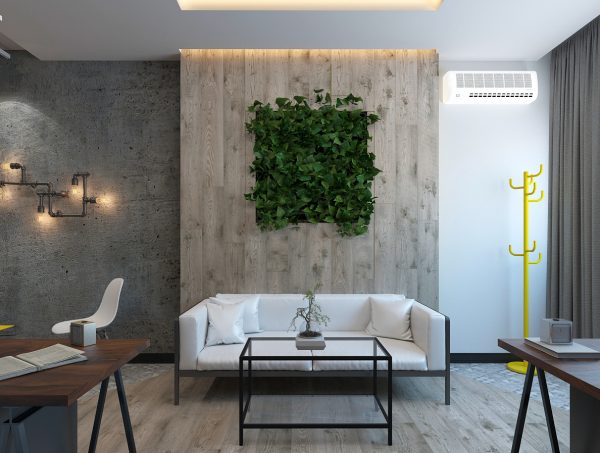
On the wall you can even build a garden. For example, in the kitchen the plant wall is planted with spices - parsley, basil, oregano, which can be cut periodically. As for inedible plants, such a mini-kindergarten usually lives up to 7 years, and dead specimens are easy to replace with new ones.
to contents ↑Phytowall Designs
To equip the vertical gardening system, various options of phytowalls are used, which are produced industrially or made on site independently:
- Phyto-module. This is a composition of living plants, having a compact size. If necessary, such a phytowall can be moved to other rooms, since it is fixed with the possibility of simple dismantling. Typically, the structure is made of a thin-walled profile with external galvanization that does not allow it to rust. The phyto-module is an easy option for zoning the space, it can be disassembled and assembled without any problems.
- Fitokartina. The walls of the case of small phytowalls are quite wide, therefore they resemble an ordinary picture frame. Herbal paintings are great for accent decoration of rooms for any purpose. It is better to place them in the most visible place so that they look as beautiful as possible in daylight and evening lighting.
- Phyto lettering. They are a variety of paintings in the form of letters. Usually made from green moss, which has undergone a special treatment.
- Herbal closet. Most often, this design is made of MDF. It consists of several separate blocks, which are placed in the desired cell in the furniture itself. At the bottom of the cabinet there is a plastic tray for collecting moisture.
- Step phyto-modules or boxes. Such devices are attached to the wall with self-tapping screws, or hung by hooks. Most often they are made from durable polyvinyl chloride with ready-made cells. For irrigation, a drip system with an electric motor is brought to the drawers, which itself pumps water into the cells. In advanced versions, humidity sensors are integrated into the system.
- Green wall, or classic phytowall. This is a large-scale composition consisting of many compartments. Live plants are planted in them or artificial "seedlings" or moss are attached. Designers are advised to maintain conciseness in the design of the rest of the interior, because the phytowall will serve as the most striking accent in the room.
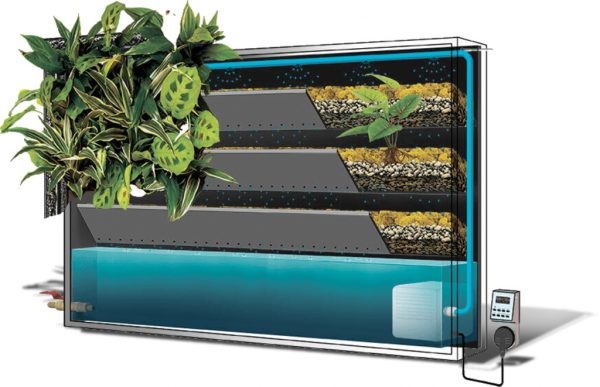
The use of phytowalls in apartments and offices
It has long been proven that the presence of plants in the offices contributes to the creation of a favorable microclimate and optimization of the working environment, and helps to relax during breaks. Fitostena in the office will decorate the interior, attract customers, make the mood of employees positive and become a real business card of the company.
Vertical green installations look chic in the interior of a house or apartment and are especially suitable for eco-style. Even in a small room, you can use small-sized eco-modules, for example, to line the green area behind the head of the bed. Phytowalls also look good in the bathroom, toilet, and kitchen. They are ideal for rooms without windows, increasing the psychological comfort of a person.
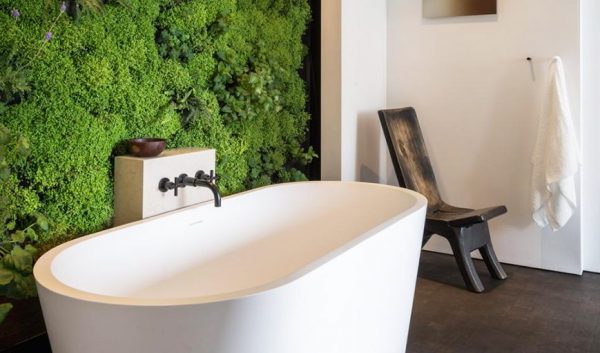
The phytowall will help to divide the room into several zones that perform different tasks in a large space. For example, with its help it is possible to equip a cozy arbor, closed from prying eyes, right in the apartment. Radial phyto-modules decorate the columns, which looks very bright, attractive. Small items can play the role of phytocarts, which are mounted on the walls even in tiny rooms.
to contents ↑Plants for phytowalls
Most indoor plants are suitable for the manufacture of phytowalls, although there are some features of their application. It is necessary to select the most unpretentious species that do not require too much light and water. On one phytowall, it is better to use either green or flowering plants, otherwise the harmonious appearance of the decor will be violated. This rule does not exclude accent decoration of phytowalls with flowers.
To equip the vertical gardening system, it is worthwhile to select only those plants that do not cause allergic reactions. It is advisable that they have no smell, because gradually it will begin to irritate the residents or even provoke a headache.Plants with a long lifespan are considered ideal, which will increase the service life of the phytostall itself. Of green plants, the following are considered the best choice:
- tradescantia;
- ferns;
- chlorophytum;
- ivy.
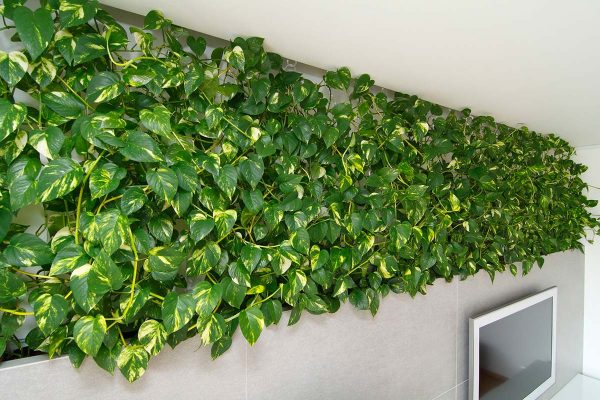
These plants are most often used to create the main background of the phytowall. Vivid accents of the design can be orchids, phytonia, pylaea.
to contents ↑Moss for phytowalls
Moss is ideal for those who plan to build a phytowall themselves. He is unpretentious, loves shade, does not require fertilizer. In addition, moss seriously improves the soundproofing of the walls, so you can forget about the noise from neighboring apartments. Most often, for vertical gardening, reindeer moss is used, which is subjected to special processing. Pre-moss canned by wetting with special solutions, painted to give brightness, apply protective compounds to prevent rotting, mold growth.
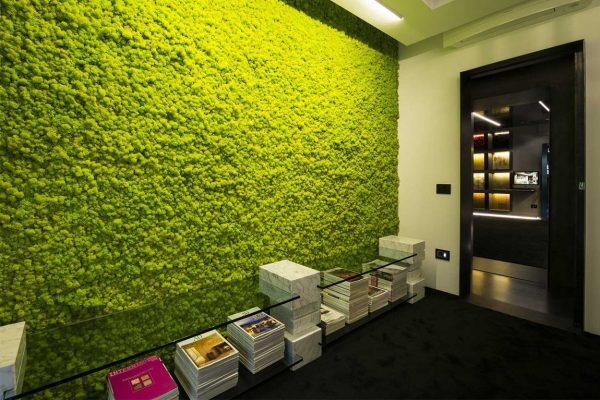
At home, you can use ordinary forest moss even without pre-treatment, but care in this case will be more difficult, and some areas will need to be replaced periodically.
to contents ↑Stabilized moss is glued onto MDF panels because it does not need land for growth. Unfortunately, it does not bring much benefit to the body and performs only a decorative role.
Flowers on a phytowall
If you decide to mount a phytowall with flowering plants, you need to pre-select harmoniously combined color compositions. Red and white flowers look very impressive on a green background (for example, spathiphyllum and anthurium, flowers in which have a similar shape and appearance). Landscaping systems with the participation of begonias, violets, Schlumbergera cactus look great. Care for such plants must be very careful, otherwise they will not bloom and may die. If orchids are chosen for the phytowall, they will have to form a separate irrigation and lighting system.
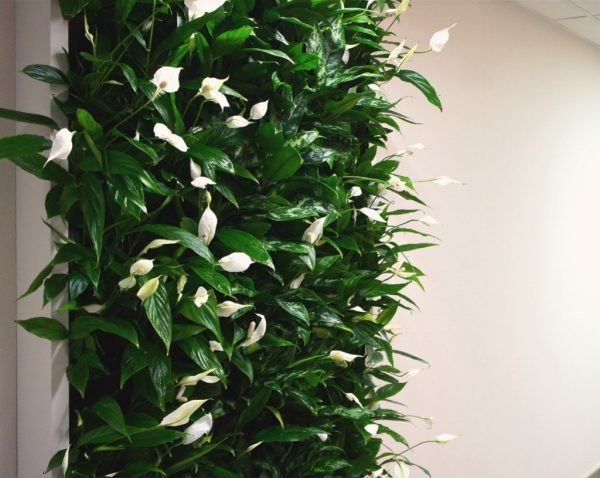
Artificial plants
Allergy sufferers and people who do not have enough time to water and transplant live plants often choose a phytomodule from artificial elements. In a similar way, it is worth doing if there are animals in the house, with prolonged absences, when there is no one to take care of the plants. Artificial greens are durable, safe, do not emit odors, and look like they are alive. On sale there are special plant blocks for phytomodules, which will be easier to build for yourself.
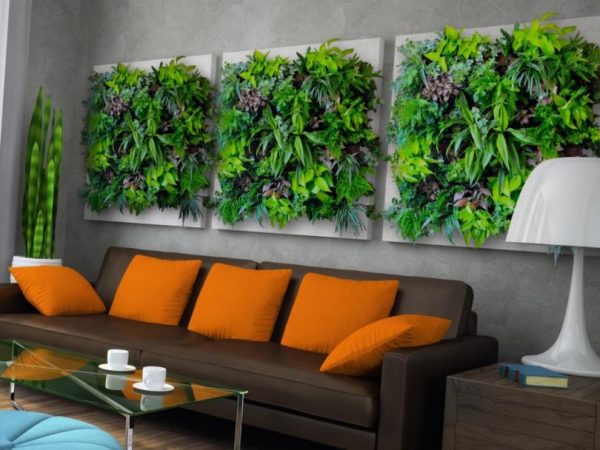
Grass
To make the phytostall look like a flat football field, you can plant ordinary lawn grass, cereals, wheat sprouts on it. For the kitchen, the phyto module of spicy herbs is perfect:
- peppermint;
- sage;
- cilantro;
- parsley;
- caraway seeds;
- Basilica
- lemon balm.
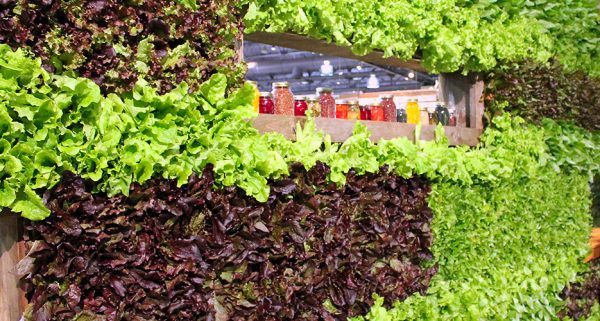
Best plants for phytostalls
Which plant families are suitable for “settling” on the phytowall? Representatives of Marantovy will become a good option - low bushy plants that do not like frequent watering and grow in the shade without problems. Representatives of the Gipoksidievye family are distinguished by longer leaves and low height and are well suited for the extreme modules of the phytowall.
Ferns - pteris, pellet, nephrolepis - give a lush top that looks very airy and beautiful. Such plants do not die even near sources of heating, do not require a lot of solar energy. The bromeliads belong to flowering plants, but you can not water them, but simply spray them from a spray bottle - this is enough for life, growth and an attractive appearance.
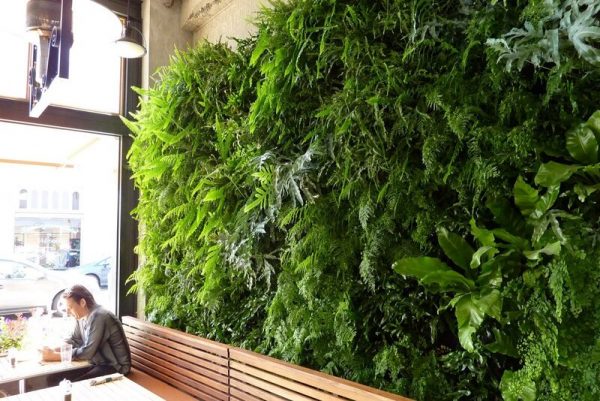
to contents ↑According to experts, ivy varieties are best suited for phytomodules. They will not die even with a severe lack of water, light, air, so they can be used in rooms without windows. Due to the wide variety of ivy, you can build an original phytowall from them.
DIY phytowall and phytomodule
Not everyone can buy a ready-made phytowall, because its price is quite high. But if you want and have patience, there is a chance to make a design with your own hands.
Beginning of work
The first step is to decide where the phytowall will be located, and precisely determine its boundaries in the room. Next, you should choose the vegetation that is well suited in all respects, and think over the design. It is advisable to sketch the future phytowall on paper so that its installation is simpler. Also, if necessary, it is necessary to indicate the position of the additional decor, if it is also planned in the design.
to contents ↑
Eco module collection rules
An important condition for the existence of the phytowall is the absence of the danger of wetting the very base - the wall in the room. Usually, a special waterproofing layer is laid on the inside of the module. If the phytowall has a solid metal or plastic frame, then waterproofing is not required.
Important rules for arranging phytowalls are as follows:
- if possible, light sources should be located as close to plants as possible;
- Before starting work, it is necessary to carefully draw the base down to the individual compartments - this will help to carry out installation with high accuracy.
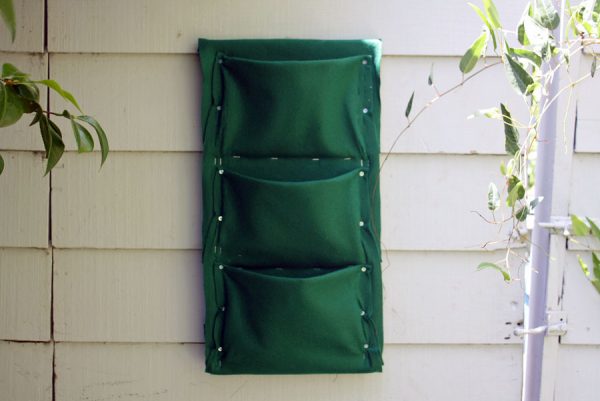
Ideas for additional decor
The phytowall, which is equipped with a backlight, will look even more attractive. For this purpose, you can use both ordinary and colored light bulbs that create interesting visual effects. Glass baguettes, small waterfalls, mirrors, shells, stones are often used as decor for phytowalls.
Tools and materials for manufacturing
Before assembly, you need to pay attention to the preparation of the frame. It will require boards or slats, a plastic or metal profile, aluminum corners or PVC pipes. The aluminum frame is not suitable for the manufacture of large heavy phytomodules, since there is a risk of sagging.
You will also need a piece of waterproof fabric, which will not allow moisture to seep out. The cheapest option is polyethylene, but it will interfere with the natural circulation of air and cause mold. Therefore, instead of polyethylene, it is better to take polypropylene, a membrane or a PVC cloth. Cells for plants must also be made of non-rotting material (a special type of felt). In addition, you need to prepare:
- drip irrigation tube with plug and hose;
- an aquarium-type submersible pump for pumping water (for each meter of phytowalls you need to take a pump with 1.5 meters of liquid rise);
- drip tray;
- soil - expanded clay or hydroponic, or sphagnum moss, which perfectly absorbs and retains water.
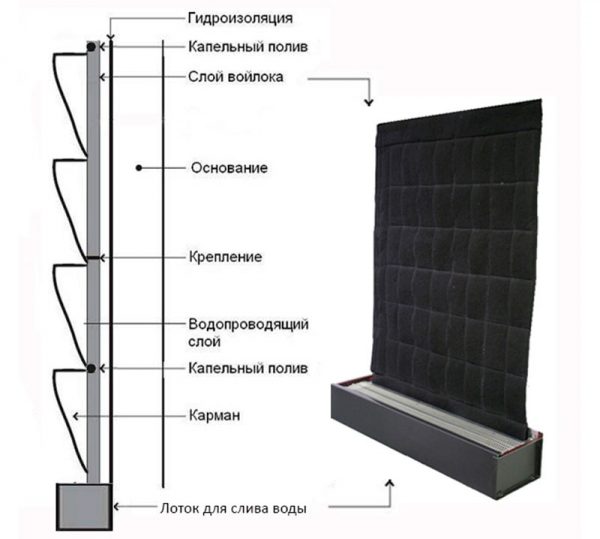
to contents ↑Also for work, tools and consumables are needed - a construction stapler, a ruler, a pencil, scissors, screws, a drill.
Assembly and installation of an eco-wall
The frame must be assembled according to the desired size, secured with screws. The following should be done:
- sew a cloth with pockets, process the seams so that the edges do not open;
- attach the web to the frame with a stapler, carefully pulling it from all sides;
- fix the module to the wall with screws, leaving a distance of about 2 cm, so as not to disturb ventilation;
- between the profile and the fabric at the top, place a PVC pipe for irrigation, closing it with a plug on one side;
- make holes in the tube so that the water flows evenly along the phytowall;
- connect the tube to the hose, connect the pump (it is desirable that it has a timer and turns on regularly);
- install a pan below the phytowall, put the pump into it.
Next, proceed to planting plants. It will be possible to change their position only in the first 2-3 days, and then they will be firmly rooted in the felt. The order of planting is as follows:
- pour the selected soil layer at about 1/3 of the height of each cell;
- get the plant out of the pot, shake the ground well;
- prune roots 1-2 cm;
- wash the roots in water;
- place the plant in the cell, having previously wrapped its lower part with a felt flap or wet moss;
- if there is a lot of space left in the cell, fill it with soil;
- plant all other plants, trying to close the space between them with leaves.
to contents ↑
Care of a phytowall
If the plants are located in a room where there are no windows at all, it is recommended to equip them with artificial lighting. Even unpretentious representatives of the flora can not live without light at all, which must always be remembered! Humidity in the room should also be suitable for a particular type of vegetation - if it is low or high, this will affect the condition of the phytowall and its appearance. Humidity can be increased by spraying water, and reduced by airing.
Regular watering is also very important. It is advisable at first to set the frequency of irrigation at least 2 times a day for 20 minutes. After a couple of days, you can evaluate the effect and change the mode, if necessary. Plant nutrition with fertilizers also needs to be done through irrigation, simply adding liquid formulations to the water. So that the plants are not too tall, they need to be nipped regularly - then the main growth will occur in width. Long shoots must be removed in a timely manner, like dried leaves and flowers.
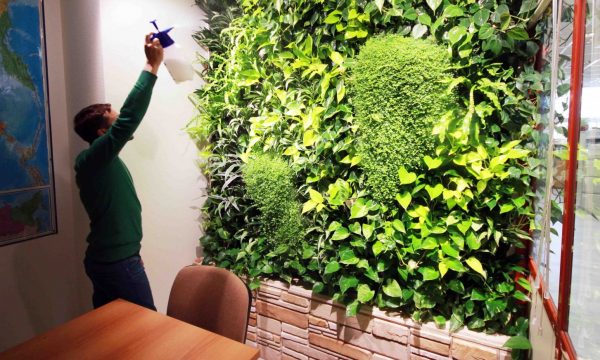
In an effort to create a beautiful interior, arranging a phytowall is an excellent solution. If you follow the technology, you can not invite a phytodesigner, but make a real green "oasis" in the apartment with your own hands!



